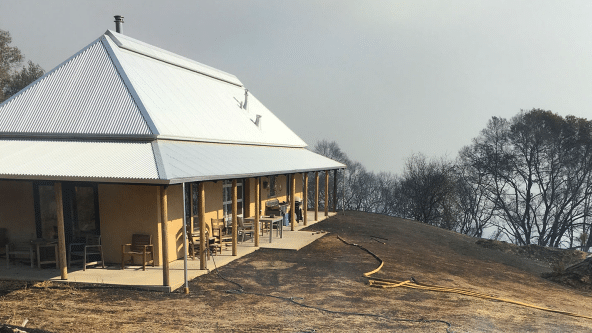Home Wildfire Safety
Wildfires are a harsh reality, with nearly 20 million acres of land scorched in recent years. For homeowners, especially those in fire-prone regions, thoughtful preparation and maintenance of a fire-wise home is critical.
While straw bale walls offer exceptional fire resistance, not everyone is already living in their dream straw house, so we wanted to share tips that can apply to all types of home construction builds. (More coming soon in a future blog on designing a fire-wise straw house as there are details to consider beyond the walls!)
Whether you are renting or a homeowner, we hope this helps you take steps towards creating a safer home place. Be sure to read to the end for a free downloadable checklist to use!
Increasing Your Home Wildfire Resilience
The Defensible Space Principle
Creating defensible space around your home is one of the most effective ways to reduce wildfire risk. The concept involves modifying vegetation and other combustible materials around your property to slow the spread of fire and provide a buffer for firefighters.
Defensible space is divided into three zones:
Immediate Zone (0-5 feet)
Keep this area clear of flammable materials like firewood, mulch, or dry vegetation. Use non-combustible materials for landscaping, such as gravel or stone. Install hardscaping elements like patios and pathways to act as firebreaks.
Intermediate Zone (5-30 feet)
Thin out trees and shrubs to create at least 10 feet of separation between tree canopies. Keep grass mowed and irrigated to prevent it from becoming fuel. Prune tree branches at least 6-10 feet above the ground to prevent a surface fire from climbing.
Extended Zone (30-100 feet)
Remove dead trees, fallen branches, and other debris. Space trees to prevent crown fires from spreading. Manage native vegetation to reduce fire intensity.
Stopping Wildfire Before It Starts
Ignition Reduction Strategies
What is outside the walls of a home matters greatly in wildfire home protection.
Here are other practical steps to reduce ignition risks:
Gutter Maintenance
Keep gutters and downspouts free of leaves and debris. Where leaf and pine needle litter collects is also where embers will collect and cause ignition.
Chimney Protection
Install spark arresters on chimneys to prevent embers from escaping.
Outdoor Furniture
Use fire-resistant furniture and cushions in outdoor living areas.
Storage
Store firewood and other combustibles at least 30 feet from your home.
Surrounding Outbuildings
Assess outbuildings on your property for their fire vulnerability. Apply similar fire-wise principles to reduce risk.
“In a prior life chapter, Dainella spent summers swinging tools on fire lines for the USFS. Here are a couple of tips from those days:
Thoughtfully maintained defensible space is #1 in an urban interface situation.
Make sure your address and neighborhood road signs are clearly visible; this will make it easier for fire crews to navigate unfamiliar areas.
Have your driveway accessible to larger trucks. If an engine crew gets assigned to your residence to protect it, it is best that they don’t have to cut their way in through low-hanging branches, and they have suitable escape routes.
Look around your property through the eyes of a firefighter and consider what might be hazardous. While you can’t do much about utility lines, you can ensure propane tanks and other flammable substances also have defensible space and, if possible, are stored away from the home. ”
Conclusion
Wildfires are unpredictable, but preparing your home can make all the difference.
Taking proactive steps not only protects your home but also enhances your family's safety and peace of mind. Start planning your fire-wise strategy today and build resilience into every aspect of your home.
Download the checklist below or visit the National Fire Protection Agency (NFPA), which has excellent resources for homeowners wanting to learn more here.
View a free Home Wildfire Safety checklist to use for your home today.
FAQ
What is defensible space? This is a natural or landscaped area around a structure that has been maintained and designed to reduce fire danger. This defensible space reduces the risk that fire will spread from one area to another, or to a structure, and provides firefighters access and a safer area from which to defend a threatened area. Firefighters sometimes do not attempt to protect structures without adequate defensible space, as it is less safe and less likely to succeed. (wikipedia)



